


MARY I
1553 - 1558
(called Bloody Mary)
(M1) Lived 1516 - 1558
|
1553
|
Lady Jane Grey reigns for
nine days. She is imprisoned and beheaded the following year.
|
|
1554
|
A large force, led by Sir Thomas Wyatt, marches on
London to prevent Mary's marriage to Philip of Spain, or to
put Princess Elizabeth on the throne. The Wyatt Rebellion
fails.
The renowned Venetian
artist Titian completes one of his major works, Venus
and Adonis. His style and technique has a marked
effect upon the development of European art.
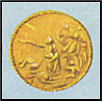 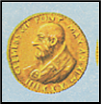
The Italian goldsmith and
sculptor Benvenuto
Cellini, renowned for the beautiful salt
cellar he made for the French king, Francis I, completes his
masterpiece, the large bronze statue of Perseus.
Under their leader
Suleyman I, the Ottoman Turks continue their conquest of the
North African coast and increase their naval presence in the
western Mediterranean.
One of the most beautiful
masses in Roman Catholic church music, Miss
ecce sacerdos, is composed by the Italian chapel-master
Giovanni Palestrina.
|
|
1555
|
By the Peace of Augsburg princes in
the Holy Roman Empire are given the freedom to choose between
the Lutheran and Catholic forms of faith. Protestantism is
thus made legal.
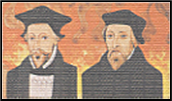
In England, Bishops
Ridley and Latimer are burnt at the stake for refusing to deny their
protestant faith. During this reign some 300 “heretics” are
put to death by “bloody Mary”.
The Muscovy Company is founded
to promote trade with Russia and proves very successful. A
further attempt is made to discover a Northeast passage but it
ends in failure.
The French physician and
astrologer Nostradamus writes Centuries, a
book of obscure prophecies in verse in which he claims to
predict events up to the end of the world in 3797.
|
|
1556
|
Thomas
Cranmer, one of the architects of the
English reformation, is burnt at the stake.
His death and those of the
Protestants Ridley
and Latimer
cause widespread discontent.
Following the death of
Humayun, Akbar, aged 13, becomes the third Mughal Emperor. He
takes over control of the government in 1560 and starts the
conquest of northern India.
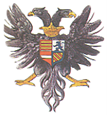
The Holy Roman Emperor
Charles V abdicates and his vast Empire, symbolised by the
double-headed eagle, is divided between his brother, Ferdinand, who becomes emperor, and his son, Philip -
husband of Queen Mary - who becomes Philip II of Spain.
|
|
1558
|
While supporting the Spanish
in their war against France, England loses the valuable port
of Calais, the last English possession on the European
mainland.
Mary I dies of a fever and is
succeeded by her half-sister, Elizabeth I, amid general
relief and Protestant rejoicing.
|
Acknowledgements
Mary I: by
Master John (active 1544-1550), 1544 – National Portrait
Gallery, London. Philip II: by the
Netherlandish painter Antonio Mor (or Moro) (c1516-1577) –
Prado Museum, Madrid. Coat of Arms:
licensed under Creative Commons. Author: Sodacan –
https://commons.wikimedia.org.
M1-1553-1558-M1-1553-1558-M1-1553-1558-M1-1553-1558-M1-1553-1558-M1-1553-1558-M1
x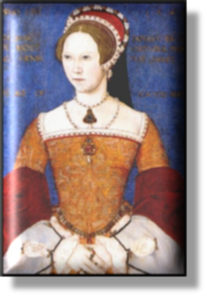 xxxxMary Tudor was born at Greenwich in 1516, the daughter
of Catherine of Aragon. Following her mother's divorce she was
harshly treated by her father's new wife Anne Boleyn. She was
forbidden to see her parents - she never saw her mother again
-, stripped of her title, and obliged to act as a lady-in-waiting
to the young Elizabeth. After Anne Boleyn's fall from favour,
however, Mary was allowed to return to Court in 1544, and, having
acknowledged Henry VIII as head of the English church, was granted
succession to the throne after her half-brother Edward.
Although still a devout Roman Catholic at heart, she thus survived
the six years of Edward's reign and, upon his untimely death in
1553, was in a position to restore publicly the faith she had
retained in private.
xxxxMary Tudor was born at Greenwich in 1516, the daughter
of Catherine of Aragon. Following her mother's divorce she was
harshly treated by her father's new wife Anne Boleyn. She was
forbidden to see her parents - she never saw her mother again
-, stripped of her title, and obliged to act as a lady-in-waiting
to the young Elizabeth. After Anne Boleyn's fall from favour,
however, Mary was allowed to return to Court in 1544, and, having
acknowledged Henry VIII as head of the English church, was granted
succession to the throne after her half-brother Edward.
Although still a devout Roman Catholic at heart, she thus survived
the six years of Edward's reign and, upon his untimely death in
1553, was in a position to restore publicly the faith she had
retained in private.
xxxxxAs we have
seen, upon the death of Edward in 1553
(E6), Mary was regarded as the rightful
heir to the throne, and she had no real difficulty in toppling
Lady Jane Grey from the seat of power within a matter of days. But
her popularity was to be short-lived. Once crowned as Queen -
the first one to rule England in her own right - she
immediately set about reversing the Protestant reforms introduced
by her father and half-brother. Papal supremacy and the Mass
were restored, and she instigated a religious purge that was to
earn her the title of "Bloody Mary", besides a great deal of
enmity. Some 280 "heretics" were burnt at the stake, including
such leading Protestant churchmen as Cranmer, Ridley and Latimer,
many in the "Smithfield fires" in London.
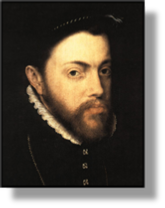 xxxxxNor was her foreign policy any more successful. In
July 1554 her marriage to the Catholic Prince Philip (illustrated), heir to the
Spanish throne, proved immensely unpopular, and led directly to a
serious rebellion under the leadership of Sir Thomas Wyatt. And it
also led to a humiliating defeat on the battlefield. In the final
year of her reign Mary was obliged to support her husband in a war
against the French. In the conflict that followed, England lost its
only remaining possession on the continent, the valuable port of
Calais.
xxxxxNor was her foreign policy any more successful. In
July 1554 her marriage to the Catholic Prince Philip (illustrated), heir to the
Spanish throne, proved immensely unpopular, and led directly to a
serious rebellion under the leadership of Sir Thomas Wyatt. And it
also led to a humiliating defeat on the battlefield. In the final
year of her reign Mary was obliged to support her husband in a war
against the French. In the conflict that followed, England lost its
only remaining possession on the continent, the valuable port of
Calais.
xxxxxThus it was
that Mary's five-year reign was little short of a disaster.
The fears over her unpopular marriage, the defeat at the hands of
the French, and the persecution of many Protestant "heretics",
including leading churchmen, caused widespread discontent and, at
times, open rebellion. Against this background, her death in
November 1558 without a direct heir came as a great relief. She
died of a fever and, it must be said, there were many in the land
who were pleased at her passing. Indeed, we are told that the
announcement of her death and the accession of her half-sister,
Elizabeth, were greeted by the ringing of bells and the lighting
of bonfires.
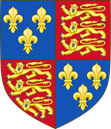






Timewise Traveller is a free
non-profit resource. However, if you have found it of
interest/value and would like to show your appreciation, the author
would welcome any contribution to Cancer Research UK.
To visit our Cancer Research
page and make a small donation, click 














 xxxx
xxxx xxxxx
xxxxx